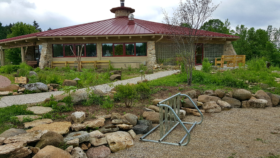
Honeybees are busy in our Bird and Butterfly Garden at Crossroads. We couldn’t be happier and no, we don’t worry about children being stung by honeybees, unless the kids are barefoot. Away from their hives, honeybees are quite docile, especially if they have lots of flowers from which to gather nectar and pollen and ……this is important…..if they have enough water. At Crossroads they have both. (We do worry about yellow jackets and wasps)
So out in our garden, the honey bees are running around in circles trying to forage. Understand that by nature, a bee is a very methodical creature. When she lands on a disk flower—say a daisy or a Black-eye Susan, she doesn’t just start poking around. She works around the flower in a spiral, starting from the outside and working in.
I need to digress. When I call a daisy a flower, I’m being inaccurate. A daisy is a composite—-a collection of many flowers. Each of the little yellow bumps is an individual flower. Same with Black-eye Susan except that the individual flowers are brownish-purple instead of yellow.
The tiny flowers do not open all at once. At first, only buds on the very outside of the floral disk open. Curiously, these outside buds contain only female parts. A flower in the female stage is easy to recognize because the female part is shaped like the letter “ Y.”
The male part of a flower is the pollen. When the flower is in its male stage, it is easy to see the pollen on a daisy. And it really stands out on a Black-eyed Susan or sunflower. When the male parts are exposed, you can see the ring of yellow against the black background of the dark floral disk.
I said the flowers don’t open all at once. At first, each tiny bud is closed. Then it opens into the male stage and releases its pollen. Finally, in the female stage, the Y-shaped parts protrude from the flower.
Now, this is neat. A bee, laden with pollen from another plant, lands on the floral disk and begins collecting nectar, beginning on the outside rim. Because the outermost flowers are open, pollen which the bee inadvertently picked up from the last flower d will rub off on the female parts.
The bee spirals her way toward the center of the floral disk. As she does so, the bee picks up the pollen exposed on the middle flowers.
Each day, the concentric circles of blooming flowers moves closer to the center of the floral disk, and because bees invariably work their way around the spiral, cross-pollination is assured.

